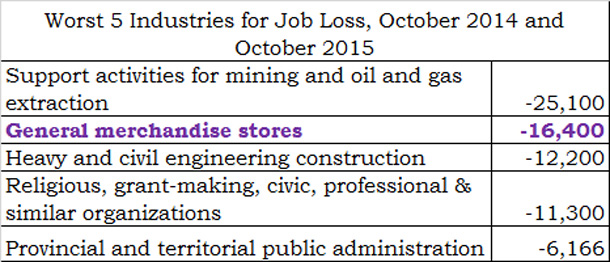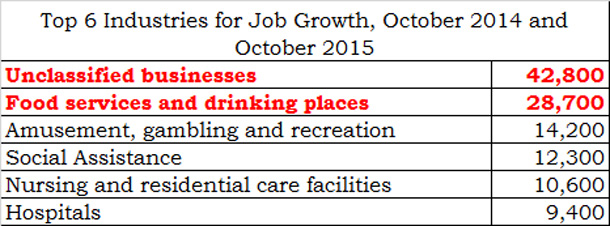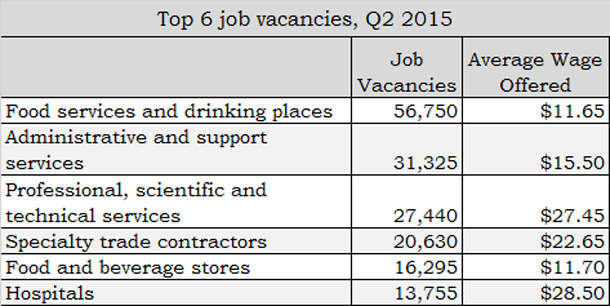This is the time of year when articles list their favourite things about last year, and their "things to watch" for the next year.
Naturally, my "things to watch" list will always include the labour market. Where have we seen the strongest job growth or worst job losses, and what are the trends that might affect this in the coming year?
We know that the employment rate (the proportion of Canadians over 15 who have a job) has never really recovered from the 2008-2009 recession. While this is partly because of demographic trends, I still think that this is an important indicator to watch, as it reflects the proportion of the adult population in paid employment. Full employment is a worthwhile goal, as jobs are still the main way that we create wealth/distribute income.
So where are the jobs going to be in 2016?
Well, we know where they weren't in 2015. Looking at Statistics Canada's most recent Survey of Employment, Payrolls and Hours data by industry, the impact of lower oil prices are clear. The table below compares the employment levels in industries at the three-digit North American Industry Classification System level. Support activities for resource extraction tops the list of job losses over the past year, by a wide margin. General merchandise stores comes in second, and I've bolded it because it is the only industry that makes the worst five list both in the past year, and since October 2008. Perhaps surprisingly, provincial and territorial public admin makes the top five list for job losses.

On a more positive note, let's see where the growth is happening. In recent years, the Survey of Employment, Payrolls and Hours data has had a disproportionate number of unclassified businesses, so it is no surprise that this is the "industry" with the most employment growth over the past year. More meaningful is the employment growth in food services, social assistance and hospitals. Again, food services is bolded because it made it into the top five list for the past year, and since October 2008. (I've included six industries here because of a connection with the job vacancy data).

So how does this job growth compare to reported vacancies, perhaps a better indicator of where short-term job growth will be coming from? Food services and drinking places tops the job vacancies list too. Unfortunately for workers, the average wage offered in this industry is the lowest of all reported in the Job Vacancy and Wage Survey.

A better indicator for workers might be where are wages rising, and where are they falling. Over time the new Job Vacancy and Wage Survey should be able to give us a decent understanding of this. Right now we only have two data points, Q1 and Q2 of 2015, when we were smack dab in the middle of an oil shock-induced recession. For what it's worth, so far the fastest growing wages on offer are in data processing, financial investments and high-tech manufacturing. The biggest wage offer declines were seen in natural resource sectors.
Where are the jobs with decent wages going to be in 2016? Demand in health care and social services will continue, but nearly all provincial governments are coming up against self-inflicted revenue constraints which will affect both hiring and wages in this sector. Low-wage jobs abound, so movements like #Fightfor15 become even more important. Unions and other civil society groups that are pushing for better employment standards for precarious workers, and for universal benefits will become even more necessary in the next few years. ![]()
Read more: Labour + Industry















Tyee Commenting Guidelines
Comments that violate guidelines risk being deleted, and violations may result in a temporary or permanent user ban. Maintain the spirit of good conversation to stay in the discussion.
*Please note The Tyee is not a forum for spreading misinformation about COVID-19, denying its existence or minimizing its risk to public health.
Do:
Do not: